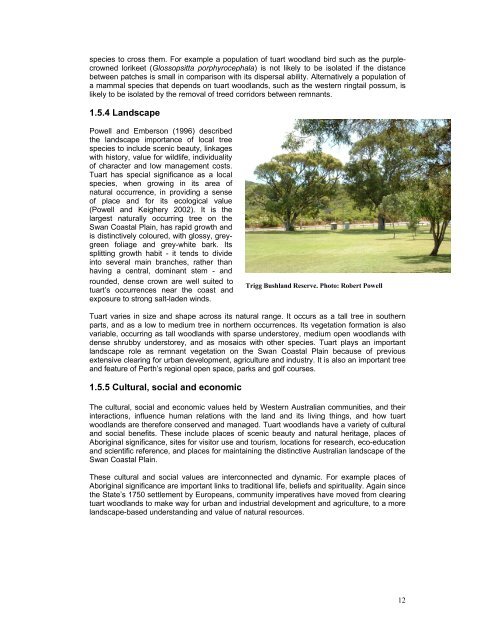DRAFT Tuart Conservation and Management Strategy
DRAFT Tuart Conservation and Management Strategy
DRAFT Tuart Conservation and Management Strategy
You also want an ePaper? Increase the reach of your titles
YUMPU automatically turns print PDFs into web optimized ePapers that Google loves.
species to cross them. For example a population of tuart woodl<strong>and</strong> bird such as the purplecrowned<br />
lorikeet (Glossopsitta porphyrocephala) is not likely to be isolated if the distance<br />
between patches is small in comparison with its dispersal ability. Alternatively a population of<br />
a mammal species that depends on tuart woodl<strong>and</strong>s, such as the western ringtail possum, is<br />
likely to be isolated by the removal of treed corridors between remnants.<br />
1.5.4 L<strong>and</strong>scape<br />
Powell <strong>and</strong> Emberson (1996) described<br />
the l<strong>and</strong>scape importance of local tree<br />
species to include scenic beauty, linkages<br />
with history, value for wildlife, individuality<br />
of character <strong>and</strong> low management costs.<br />
<strong>Tuart</strong> has special significance as a local<br />
species, when growing in its area of<br />
natural occurrence, in providing a sense<br />
of place <strong>and</strong> for its ecological value<br />
(Powell <strong>and</strong> Keighery 2002). It is the<br />
largest naturally occurring tree on the<br />
Swan Coastal Plain, has rapid growth <strong>and</strong><br />
is distinctively coloured, with glossy, greygreen<br />
foliage <strong>and</strong> grey-white bark. Its<br />
splitting growth habit - it tends to divide<br />
into several main branches, rather than<br />
having a central, dominant stem - <strong>and</strong><br />
rounded, dense crown are well suited to<br />
tuart’s occurrences near the coast <strong>and</strong><br />
exposure to strong salt-laden winds.<br />
Trigg Bushl<strong>and</strong> Reserve. Photo: Robert Powell<br />
<strong>Tuart</strong> varies in size <strong>and</strong> shape across its natural range. It occurs as a tall tree in southern<br />
parts, <strong>and</strong> as a low to medium tree in northern occurrences. Its vegetation formation is also<br />
variable, occurring as tall woodl<strong>and</strong>s with sparse understorey, medium open woodl<strong>and</strong>s with<br />
dense shrubby understorey, <strong>and</strong> as mosaics with other species. <strong>Tuart</strong> plays an important<br />
l<strong>and</strong>scape role as remnant vegetation on the Swan Coastal Plain because of previous<br />
extensive clearing for urban development, agriculture <strong>and</strong> industry. It is also an important tree<br />
<strong>and</strong> feature of Perth’s regional open space, parks <strong>and</strong> golf courses.<br />
1.5.5 Cultural, social <strong>and</strong> economic<br />
The cultural, social <strong>and</strong> economic values held by Western Australian communities, <strong>and</strong> their<br />
interactions, influence human relations with the l<strong>and</strong> <strong>and</strong> its living things, <strong>and</strong> how tuart<br />
woodl<strong>and</strong>s are therefore conserved <strong>and</strong> managed. <strong>Tuart</strong> woodl<strong>and</strong>s have a variety of cultural<br />
<strong>and</strong> social benefits. These include places of scenic beauty <strong>and</strong> natural heritage, places of<br />
Aboriginal significance, sites for visitor use <strong>and</strong> tourism, locations for research, eco-education<br />
<strong>and</strong> scientific reference, <strong>and</strong> places for maintaining the distinctive Australian l<strong>and</strong>scape of the<br />
Swan Coastal Plain.<br />
These cultural <strong>and</strong> social values are interconnected <strong>and</strong> dynamic. For example places of<br />
Aboriginal significance are important links to traditional life, beliefs <strong>and</strong> spirituality. Again since<br />
the State’s 1750 settlement by Europeans, community imperatives have moved from clearing<br />
tuart woodl<strong>and</strong>s to make way for urban <strong>and</strong> industrial development <strong>and</strong> agriculture, to a more<br />
l<strong>and</strong>scape-based underst<strong>and</strong>ing <strong>and</strong> value of natural resources.<br />
Photo: Government Printing Office<br />
12

















